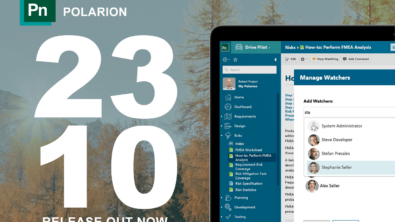Adding Agility To Your Requirements Management

Software development in general is a complex process, as such it must be developed in accordance to expectations, needs and ultimately the requirements of the product. However, when it comes to defining and managing these requirements, traditional waterfall and v-model approaches to software development differ quite significantly in comparison to Agile methods. The Agile manifesto, the corner stone of Agile software development puts an emphasis on reducing documentation. Subsequently, organizations leveraging Agile methodologies put less of an importance on requirements definition and management. However, this is how things fall apart Christopher Lindquist states in CIO Magazine, “Fixing the Requirements Mess,” “As many as 71% of (embedded) software projects that fail, do so because of poor requirements management, making it the single biggest reason for project failure.” Project failure leads to wasted investments, excess cost, and lost revenue.
With this knowledge in hand, let’s examine at how to do requirements management the Agile way i.e. right way.
Agile Vs Traditional Software Development
As outlined above, one of the core principles of the Agile manifesto states that working software is imperative over comprehensive documentation, it never states that documentation or planning is not required or useful for software development. As a result, real world implementations of Agile methodologies use an adaptive planning method while the traditional methods of software development require planning and documentation to prepared weeks, and sometime months in advance of development.

As such, the entire purpose of agile requirements management in comparison to traditional requirements management should be to eliminate excess documentation that hindering the process and leave only what’s essential and adds value to the product development process.
So, what’s essential and how do you define requirements?
Defining Requirements
The bare minimum in defining requirements is to have a simple product requirements document (PRD). This document should address what is to be developed, its features, functionalities and how it’s supposed to behave. But what good is a document that sits somewhere and does nothing. The key to Agile software development is collaboration and communication. Agile methodologies place an emphasis on a shared understanding between stakeholders and technical teams. If both sides understand each other, it becomes easier and more seamless to get the requirements right. Therefore, you need a platform where you can easily facilitate communication between stakeholders and development on the PRD.
Defining requirements is the first step, next comes managing requirements. Once you have your requirements defined, how do you manage them? How do you ensure communication with all stakeholder on changes? because changes happen.
Communication
Agile software development focuses on developing working software pieces during predefined period time, usually in 2 weeks cycles aka sprints. These software pieces can be reviewed by anyone involved, including the stakeholders/product owners themselves.
This brings us to another important distinction between Agile and traditional methodologies. Stakeholder are involved in the development process right from the start and remain involved throughout the entire development process unlike traditional v-model or waterfall approaches to software development. As such stakeholder input is consistently fed into the development process to help the development team understand the requirements regarding software functionality and what it should do. This constant communication and incremental revision of the requirements during the development process ensures that what is developed is correct.
Another aspect of Agile methodologies that fosters increased communication are product backlogs aka requirements backlogs. These backlogs consist of user stories, which are crucial parts of the requirements. In essence they describe software functionality and amount of time it would take to develop said functionality. The prioritization of this backlog is where stakeholders come in and this is crucial aspect of Agile software development where stakeholders determine prioritization of tasks that need to be completed based on their strategy and objectives. The management of requirements in such a way fosters deep communication between stakeholders and development teams. In other words, requirements are being added and prioritized to the product backlog in a such a way that everyone understands their impact on the upcoming work.

This way development teams clearly understand the requirements and determine the best way to implement them. By further grooming the backlog, technical teams also improve communication and collaboration between themselves. Furthermore, when you consider that stakeholders are always involved, it becomes easier to capture and refine requirements along the way. That way you can guarantee that the project won’t end up in disarray due to the misunderstandings of project goals.
Summary
Agile methodologies have been at the forefront of software development for a long time now and have already proven themselves. Software development is a dynamic process, traditional methods simply lack the transparency needed for product requirements to be integrated seamlessly. This can easily lead to unnecessary delays and increased costs. Moreover, the lack of adaptive flexibility in traditional methods makes it difficult for a project to shift from its current course once it’s well underway.
On the other hand, the Agile approach fosters ongoing improvements, specific time frames for development cycles and quicker delivery of value to the end users, which makes it more appealing. With that in mind, the value from Agile methodologies is a direct result in most part by the clarity and excellence of requirements that are fed into the development process and how over time they are clarified through stakeholder involvement. With an agile approach to requirements early in the software lifecycle, the entire process can be made more seamless, to begin with.
When it comes to agile requirements management, requirements management takes on a new approach that’s focused on value rather than documentation. It focuses on a collaborative environment that will ensure that everyone is on the right page at the right time with the right information regarding software piece that needs to be delivered.
If you want to learn more about how to modernize your legacy requirements management tool chain click the button below.


